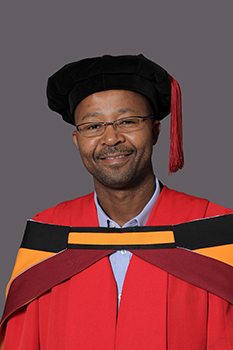
Prof Monwabisi Ralarala tackled the serving of justice from a linguistic viewpoint.
Photo: Supplied |
In 2012, local and international media was saturated with reports of the Eugène Terre’Blanche murder trial. At the judgment, Judge John Horn read a lengthy extensive document, of which three pages were dedicated to voicing his concern about how police officers distort statements in the process of translation. Considering the fact that statements are the entry points to the criminal justice system, Prof Monwabisi Ralarala’s attention was drawn to the negative impact such distortion had insofar as the administration of justice was concerned. Of the three PhD degrees conferred by the University of the Free State (UFS) Faculty of Humanities at the 2015 Summer Graduation, one was in Language Practice with Prof Ralarala’s name on it.
Prof Ralarala’s research interests in language rights, forensic linguistics, and translation studies led him to use the Terre’Blanche trial as the basis for his second PhD case study titled: Implications and explications of police translation of complainants' sworn statements: evidence lost in translation. The doctoral dissertation focused on police stations in the Xhosa-speaking community of Khayelitsha in Cape Town.
Language and the law
When the victim of a crime approaches the South African Police Services (SAPS), the requirements are that a sworn statement be taken. However, as a prerequisite, the narration needs to be translated into English. “The process unfolds in this manner: the complainant or the person laying the charges speaks in a language that they understand, and then the police officers translate that information into English because English is still the de facto language of record,” explained Prof Ralarala.
In the process of translation, the original narrative is lost, and so is some of the evidence. “They [the statements] have to be packaged in a certain way, in the form of a summary. As a police officer, you have to discard all the original narrative and create another narrative which is in English,” added the Associate Professor and Institutional Language Coordinator at the Cape Peninsula University of Technology.
Evidence is the basis of any court case and, when it is translated by police officers who do not hold the credentials of professional translators, a problem inevitably arises.
Because police officers are not trained in translation, “Some of the statements are filled with distortions, changing of information all together. In some cases, one would come across a case which was initially an assault but then - through the change and transformation, re-narration, retelling of the story by someone else - it becomes a case of attempted murder.”
Considering that a statement determines a suspect’s fate, it becomes all the more important to ensure that accuracy is upheld.
His internal and external supervisors, Prof Kobus Marais and Prof Russel Kaschula from the UFS and Rhodes University respectively stated that his PhD work has been hailed as a gem by international scholars. “According to one international assessor, he has made an exceptional contribution to the humanities and social sciences in general and to the fields of linguistics and translation studies in particular.”
Reshaping the landscape
According to Prof Ralarala, there are huge gaps in the translated versions of statements which create a problem when a ruling is made. Some of the recommendations put forward in his dissertation to bridge that gap are:
• to review the language policy insofar as the criminal justice system is concerned. The languages we speak are official and constitutionally embraced, and they hold the same status as English, hence they need to be used in criminal justice processes;
• to revisit the constitution and review if the provisions made for the Nguni languages are implemented;
• to supplement paper and pen with technology such as tape recorders. Statements can be revisited in cases where a controversy arises;
• to deploy professional translators and interpreters at police stations;
• to design a manual for police officers which contains all the techniques on how a statement should be taken.
• to enforce constitutional provisions in order to reinforce the language implementation plan in as far as African languages are concerned .
These recommendations serve to undo or eliminate any perceived injustices perpetuated and institutionalised by current linguistic and formal practices in South Africa's criminal justice system.